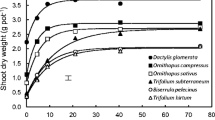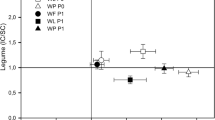Abstract
The capacity of plant roots to increase their carboxylate exudation at a low plant phosphorus (P) status is an adaptation to acquire sufficient P at low soil P availability. Our objective was to compare crop species in their adaptive response to a low-P availability, in order to gain knowledge to be used for improving crop P-acquisition efficiency from soils that are low in P or that have a high capacity to retain P. In the present screening study we compared 13 crop species, grown in sand at either 3 or 300 μM of P, and measured root mass ratio, cluster-root development, rhizosphere pH and carboxylate composition of root exudates. Root mass ratio decreased with increasing P supply for Triticum aestivum L., Brassica napus L., Cicer arietinum L. and Lens culinaris Medik., and increased only for Pisum sativum L., while the Lupinus species and Vicia faba L. were not responsive. Lupinus species that had the potential to produce root clusters either increased or decreased biomass allocation to clusters at 300 μM of P compared with allocation at 3 μM of P. All Lupinus species acidified their rhizosphere more than other species did, with average pH decreasing from 6.7 (control) to 4.3 for Lupinus pilosus L. and 5.9 for Lupinus atlanticus L.; B. napus maintained the most alkaline rhizosphere, averaging 7.4 at 300 μM of P. Rhizosphere carboxylate concentrations were lowest for T. aestivum, B. napus, V. faba, and L. culinaris than for the other species. Exuded carboxylates were mainly citrate and malate for all species, with the exception of L. culinaris and C. arietinum, which produced mainly citrate and malonate. Considerable variation in the concentration of exuded carboxylates and protons was found, even with a genus. Cluster-root forming species did not invariably have the highest concentrations of rhizosphere carboxylates. Lupinus species varied both in P-uptake and in the sensitivity of their cluster-root development to external P supply. Given the carbon cost of cluster roots, a greater plasticity in their formation and exudation (i.e. reduced investment in cluster roots and exudation at higher soil P, a negative feedback response) is a desirable trait for agricultural species that may have variable access to readily available P.









Similar content being viewed by others
References
Allen DG, Jeffery RC (1990) Methods for the analysis of phosphorus in Western Australian Soils. Report on Investigation No. 37. Chemistry Centre of Western Australia, Perth
Barbas C, Garcia JAL, Manero FJG (1999) Separation and identification of organic acids in root exudates of Lupinus luteus by capillary zone electrophoresis. Phytochem Anal 10:55–59
Bolland MDA (1997) Comparative phosphorus requirement of four lupin species. J Plant Nutr 20:1239–1253
Bolland MDA, Paynter BH (1994) Critical phosphorus concentrations for burr medic, yellow serradella, subterranean clover, and wheat. J Plant Nutr 25:385–394
Bolland MDA, Siddique KHM, Loss SP, Baker MJ (1999) Comparing responses of grain legumes, wheat and canola to applications of superphosphate. Nutr Cycling Agroecosyst 53:157–175
Brouwer R (1963) Some aspects of the equilibrium between overground and underground plant parts. Meded Inst Biol Scheik Onderz 213:31–39
Brouwer R (1983) Functional equilibrium: sense or nonsense? Neth J Agric Sci 31:335–348
Cawthray GR (2003) An improved reversed-phase liquid chromatographic method for the analysis of low-molecular mass organic acids in plant exudates. J Chromatogr A 1011:233–240
Colwell JD (1963) The estimation of the phosphorus fertiliser requirements of wheat in southern New South Wales by soil analysis. Aust J Exp Agric Anim Husb 3:190–197
De Vos CR, Lubberding HJ, Bienfait HF (1986) Rhizosphere acidification as a response to iron deficiency in bean plants. Plant Physiol 81:842–846
Diem HG, Duhoux E, Zaid H, Arahou M (2000) Cluster roots in Casuarinaceae: role and relationship to soil nutrient factors. Ann Bot 85:929–936
Dinkelaker B, Römheld V, Marschner H (1989) Citric acid excretion and precipitation of calcium citrate in the rhizosphere of white lupin (Lupinus albus L.). Plant Cell Environ 12:285–292
Gahoonia TS, Nielsen NE (1998) Direct evidence on participation of root hairs in phosphorus (32P) uptake from soil. Plant Soil 198:147–152
Gahoonia TS, Nielsen NE (2004) Barley genotypes with long root hairs sustain high grain yields in low-P field. Plant Soil 262:55–62
Gahoonia TS, Claassen N, Jungk A (1992) Mobilization of phosphate in different soils by ryegrass supplied with ammonia or nitrate. Plant Soil 140:241–248
Gardner WK, Barber DA, Parbery DG (1983) The acquisition of phosphorus by Lupinus albus L. III. The probable mechanism by which phosphorus movement in the soil/root interface is enhanced. Plant Soil 70:107–124
Gerke J, Römer W, Jungk A (1994) The excretion of citric and malic acid by proteoid roots of Lupinus albus L.; effects on soil solution concentrations of phosphate, iron, and aluminum in the proteoid rhizosphere in samples of an oxisol and a luvisol. Z Pflanzenernähr Bodenk 157:289–294
Hagström J, James WM, Skene KR (2001) A comparison of structure, development and function in cluster roots of Lupinus albus L. under phosphate and iron stress. Plant Soil 232:81–90
Hinsinger P (2001) Bioavailability of soil inorganic P in the rhizosphere as affected by root-induced chemical changes: a review. Plant Soil 237:173–195
Hinsinger P, Plassard C, Tang C, Jaillard B (2003) Origins of root mediated pH changes in the rhizosphere and their responses to environmental constraints: a review. Plant Soil 248:43–59
Hocking PJ, Jeffery S (2004) Cluster-root production and organic acid exudation in a group of Old-World lupins and a New-World lupin. Plant Soil 258:135–150
Hoffland E, Findenegg GR, Nelemans JA (1989) Solubilization of rock phosphate by rape. II. Local root exudation of organic acids as a response to P-starvation. Plant Soil 113:161–165
Holford ICR (1997) Soil phosphorus: its measurement, and its uptake by plants. Aust J Agric Res 35:227–239
Jeffery DW (1967) Phosphate nutrition of Australian heath plants. I. The importance of proteoid roots in Banksia (Proteaceae). Aust J Bot 15:403–411
Johnson JF, Vance CP, Allan DL (1996) Phosphorus deficiency in Lupinus albus. Altered lateral root development and enhanced expression of phosphoenolpyruvate carboxylase. Plant Physiol 112:31–41
Jones DL (1998) Organic acids in the rhizosphere—a critical review. Plant Soil 205:25–44
Jones DL, Dennis PG, Owen AG, Van Hees PAW (2003) Organic acid behavior in soils—misconceptions and knowledge gaps. Plant Soil 248:31–41
Keerthisinghe G, Hocking PJ, Ryan PR, Delhaize E (1998) Effect of phosphorus supply on the formation of proteoid roots of white lupin (Lupinus albus L.). Plant Cell Environ 21:467–478
Kemp PD, Blair GJ (1994) Phosphorus efficiency in pasture species. VIII. Ontogeny, growth, P acquisition and P utilization of Italian ryegrass and phalaris under P deficient and P sufficient conditions. Aust J Agric Res 45:669–688
Kitson RE, Mellon MG (1944) Colorimetric determination of phosphorus as molybdovanadophosphoric acid. Ind Eng Chem Anal Ed 16:379
Lambers H, Chapin FS III, Pons TL (1998) Plant physiological ecology. Springer, Berlin Heidelberg New York
Lambers H, Cramer MD, Shane MW, Wouterlood M, Poot P, Veneklaas EJ (2003) Structure and functioning of cluster roots and plant responses to phosphate deficiency. Plant Soil 248:ix–xix
Lawes Agricultural Trust (2003) Genstat, Edition 6.1. VSN International Ltd, Oxford
Li C, Liang R (2005) Root cluster formation and citrate exudation of white lupin (Lupinus albus L.) as related to phosphorus availability. J Integr Plant Biol 47:172–177
Li L, Yang S, Li X, Zhang F, Christie P (1999) Interspecific complementary and competitive interactions between intercropped maize and faba bean. Plant Soil 212:105–114
Ligaba A, Yamaguchi M, Shen H, Sasaki T, Yamamoto Y, Matsumoto H (2004) Phosphorus deficiency enhances plasma membrane H+-ATPase activity and citrate exudation in greater purple lupin (Lupinus pilosus). Funct Plant Biol 31:1075–1083
Lynch JP (1995) Root architecture and plant productivity. Plant Physiol 109:7–13
Neumann G, Römheld V (1999) Root excretion of carboxylic acids and protons in phosphorus-deficient plants. Plant Soil 211:121–130
Neumann G, Massonneau A, Martinoia E, Römheld V (1999) Physiological adaptations to phosphorus deficiency during proteoid root development in white lupin. Planta 208:373–382
Niklas KJ (1994) Plant allometry: the scaling of form and process. University of Chicago Press, Chicago
Nuruzzaman M, Lambers H, Bolland MDA, Veneklaas EJ (2005a) Phosphorus benefits of different grain legume crops to subsequent wheat grown in different soils of Western Australia. Plant Soil 271:175–187
Nuruzzaman M, Lambers H, Bolland MDA, Veneklaas EJ (2005b) Phosphorus uptake by grain legumes and subsequently grown wheat at different levels of residual phosphorus fertiliser. Aust J Agric Res 56:1041–1047
Parfitt RL, Childs CW (1988) Estimation of forms of Fe and Al: a review, and analysis of contrasting soils by dissolution and Moessbaurer methods. Aust J Soil Res 26:121–144
Reuter DJ, Edwards DG, Wilhelm NS (1997) Temperate and tropical crops. In: Reuter DJ, Robinson JB (eds) Plant analysis: an interpretation manual. CSIRO Publishing, Melbourne, pp. 83–284
Römer W, Kang D, Egle K, Gerke J, Keller H (2000) The acquisition of cadmium by Lupinus albus L., L. angustifolius L., and Lolium multiflorum Lem. J Plant Nutr Soil Sci 163:623–628
Ryan PR, Delhaize E, Jones DL (2001) Function and mechanism of organic anion exudation from plant roots. Annu Rev Plant Physiol 52:527–560
Searle PL (1984) The Berthelot or indophenol reaction and its use in the analytical chemistry of nitrogen. Analyst 109:549–568
Shane MW, Lambers H (2005) Cluster roots: a curiosity in context. Plant Soil 274:99–123
Shane MW, de Vos M, De Roock S, Cawthray GR, Lambers H (2003) Effects of external phosphorus supply on internal phosphorus concentration and the initiation, growth and exudation of cluster roots in Hakea prostrata R.Br. Plant Soil 248:209–219
Shane MW, Dixon KW, Lambers H (2005) The occurrence of dauciform roots amongst Western Australian reeds, rushes and sedges, and the impact of phosphorus supply on dauciform-root development in Schoenus unispiculatus (Cyperaceae). New Phytol 165:887–898
Siddique KHM, Sykes J (1997) Pulse production in Australia past, present and future. Aust J Exp Agric 37:103–111
Smith S, Read D (1997) Mycorrhizal symbiosis, 2nd edn. Academic, San Diego
Steen I (1998) Phosphorus management in the 21st century. Management of a non-renewable resource. Phosphorus Potassium 217:25–31
Vance C (2001) Symbiotic nitrogen fixation and phosphorus acquisition. Plant nutrition in a world of declining renewable resources. Plant Physiol 127:390–397
Veneklaas EJ, Stevens T, Cawthray GR, Turner NC, Grigg AM, Lambers H (2003) Chickpea and white lupin rhizosphere carboxylates vary with soil properties and enhance phosphorus uptake. Plant Soil 248:187–197
Wouterlood M, Cawthray GR, Turner S, Lambers H, Veneklaas EJ (2004a) Rhizosphere carboxylate concentrations of chickpea are affected by genotype and soil type. Plant Soil 261:1–10
Wouterlood M, Cawthray GR, Scanlon T, Lambers H, Veneklaas EJ (2004b) Carboxylate concentrations in the rhizosphere of lateral roots of chickpea (Cicer arietinum) increase during plant development, but are not correlated with phosphorus status of soil or plants. New Phytol 162:745–753
Wouterlood M, Lambers H, Veneklaas EJ (2005) Plant phosphorus status has a limited influence on the concentration of phosphorus-mobilising carboxylates in the rhizosphere of chickpea. Funct Plant Biol 32:153–159
Zhang FS, Ma J, Cao YP (1997) Phosphorus deficiency enhances root exudation of low-molecular weight organic acids and utilisation of sparingly soluble inorganic phosphates by radish (Raphanus satiuvs L.) and rape (Brassica napus L.) plants. Plant Soil 196:261–264
Acknowledgements
This research was part of an Australian Research Council Strategic Partnerships with Industry—Research and Training scheme funding a PhD project in collaboration with the Department of Agriculture Western Australia and CSBP FutureFarm. Thanks to Chris Szota, Tim Scanlon and Alasdair Grigg for assisting with the harvest, Madeleine Wouterlood for analytical advice and Matt Denton for his valued comments on the manuscript.
Author information
Authors and Affiliations
Corresponding author
Rights and permissions
About this article
Cite this article
Pearse, S.J., Veneklaas, E.J., Cawthray, G.R. et al. Carboxylate release of wheat, canola and 11 grain legume species as affected by phosphorus status. Plant Soil 288, 127–139 (2006). https://doi.org/10.1007/s11104-006-9099-y
Received:
Accepted:
Published:
Issue Date:
DOI: https://doi.org/10.1007/s11104-006-9099-y




